It’s hard to believe that after 7 long years of work, we’re just 2 short weeks away from finally releasing the Floret Original seed varieties out into the world! I feel like I’ve been waiting for this moment for an eternity and can’t wait to see them all growing in your gardens and on your farms this coming season. The official release date is Tuesday, February 6.
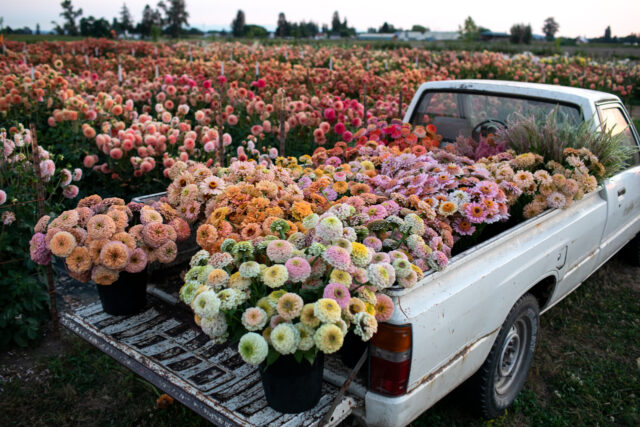 I thought now would be a great time to introduce you to these magical little plant souls and share a bit more about what makes them so special. Each variety has a unique personality and while at first glance some might look a bit similar, they are all quite different when you get to know them.
I thought now would be a great time to introduce you to these magical little plant souls and share a bit more about what makes them so special. Each variety has a unique personality and while at first glance some might look a bit similar, they are all quite different when you get to know them.
 I’ve organized this post into three main sections. First, we’ll explore the 12 celosia varieties that we’re offering, then deep dive into zinnias (we have 10 beautiful mixes!), and end with dahlias which I know so many people are excited about.
I’ve organized this post into three main sections. First, we’ll explore the 12 celosia varieties that we’re offering, then deep dive into zinnias (we have 10 beautiful mixes!), and end with dahlias which I know so many people are excited about.
But before we dive into this introduction, if you don’t already know the backstory about this project, be sure to read Floret Originals: An Update on our Breeding Program.
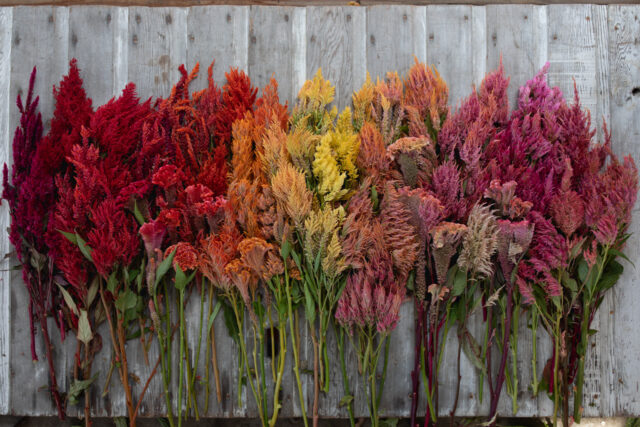 The first group of plants that I want to share with you is celosia. The reason I’ve chosen to highlight them first is because I feel like they are always passed over in favor of fancier, showier blooms!
The first group of plants that I want to share with you is celosia. The reason I’ve chosen to highlight them first is because I feel like they are always passed over in favor of fancier, showier blooms!
 However, if you’re growing flowers to arrange with, these heat lovers are an indispensable addition to your cutting garden and have your back when it comes to churning out bouquet ingredients.
However, if you’re growing flowers to arrange with, these heat lovers are an indispensable addition to your cutting garden and have your back when it comes to churning out bouquet ingredients.
These hardworking plants are vigorous, free-flowering, and easy to grow. Their fuzzy, velvet-like flowers come in a distinct range of shapes, including fans, plumes, and brains that are a wonderful accent for arrangements, plus they can be dried and used any time of the year.

 ‘Autumn Blaze’ is a riot of rich fall tones, including coral, copper, bronze, cherry, rose gold, rhubarb, and amber. The iridescent shimmering plumes come in a multitude of shapes and sizes, including dense candelabras, long, wispy spires, and textural spiky quills.
‘Autumn Blaze’ is a riot of rich fall tones, including coral, copper, bronze, cherry, rose gold, rhubarb, and amber. The iridescent shimmering plumes come in a multitude of shapes and sizes, including dense candelabras, long, wispy spires, and textural spiky quills.
Stocky, heavily branching plants have a unique range of stem and foliage colors. From a distance, the plants look as if they are about to burst into flames!

 ‘Glowing Embers’ is a selection that was made from ‘Autumn Blaze’ and features a narrower range of colors including copper, bronze, coral, smoky rose, muted tangerine, and gold. The velvety plumes come in various shapes and sizes, including dense textural clusters, feather-like wands, and long, slender wisps.
‘Glowing Embers’ is a selection that was made from ‘Autumn Blaze’ and features a narrower range of colors including copper, bronze, coral, smoky rose, muted tangerine, and gold. The velvety plumes come in various shapes and sizes, including dense textural clusters, feather-like wands, and long, slender wisps.
Stocky, heavily branching plants have green foliage with a bronze cast that complements the unusual muted coloring found in the flowers.
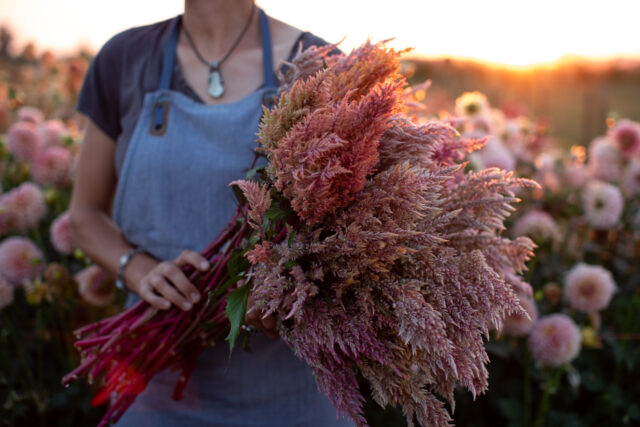
 ‘Rose Gold’ is another special color range that was discovered in ‘Autumn Blaze’ a few years back. The color palette is much more narrow and includes rose gold, blush, and champagne plumes that look as if they have been dusted with iridescent glitter.
‘Rose Gold’ is another special color range that was discovered in ‘Autumn Blaze’ a few years back. The color palette is much more narrow and includes rose gold, blush, and champagne plumes that look as if they have been dusted with iridescent glitter.
The stocky, heavily branching plants have dark ruby-red stems with cranberry-veined leaves that perfectly offset the antique-looking metallic flower heads. They are a flower arranger’s dream!

 If you’re only looking at the plumes cut from the plant, one might think that ‘Vintage Rose’ is the same as ‘Rose Gold’, but the two, while similarly colored, are actually quite different.
If you’re only looking at the plumes cut from the plant, one might think that ‘Vintage Rose’ is the same as ‘Rose Gold’, but the two, while similarly colored, are actually quite different.
‘Vintage Rose’ is twice the height of ‘Rose Gold’ and much more feathery. The flowers are a heartbreakingly beautiful blend of blush, pewter, and sunbleached velvet that looks like it’s from another era. It’s the perfect color range for wedding work.

 Next up is ‘Summer Sherbet’. This beautiful, free-flowering mix produces giant velvety plumes in rose-pink, blush, coral, and the softest peach. The heat-loving plants have light apple-green foliage and long, slender stems that are perfect for arranging.
Next up is ‘Summer Sherbet’. This beautiful, free-flowering mix produces giant velvety plumes in rose-pink, blush, coral, and the softest peach. The heat-loving plants have light apple-green foliage and long, slender stems that are perfect for arranging.
The color palette is super useful for many different types of bouquets because it mixes so well with other ingredients.

 A few years back, Eric (our seed specialist) started experimenting with trying to isolate the most textural, feathery plumes in the ‘Summer Sherbet’ mix, and create a narrower, more vivid color range, and that’s how ‘Spun Sugar’ was born.
A few years back, Eric (our seed specialist) started experimenting with trying to isolate the most textural, feathery plumes in the ‘Summer Sherbet’ mix, and create a narrower, more vivid color range, and that’s how ‘Spun Sugar’ was born.
This beautiful warm, glowing mix produces giant shimmering, textural plumes in a range of peachy tangerine, soft coral, pinky apricot, and smoky rose. These productive plants have long, slender stems, giant spaghetti-like flower heads, and light green foliage.

 In the early days, ‘Summer Sherbet’ was a much broader range of colors which included some yellows and greens. I had always wanted to tease the fresh, clean green out of this variety and finally succeeded with ‘Limonata’.
In the early days, ‘Summer Sherbet’ was a much broader range of colors which included some yellows and greens. I had always wanted to tease the fresh, clean green out of this variety and finally succeeded with ‘Limonata’.
It is a beautiful pale creamy lime blend that looks more like a foliage than a flower. Plants have a vigorous branching habit and produce an abundance of long, wispy chartreuse spires that add a freshness to arrangements. The colors mix well with almost everything. ‘Limonata’ is similar to a hybrid variety of celosia called ‘Sylphid’, but the great thing about this beauty is that you can easily save the seed from it.

 ‘Raspberry Lemonade’ also originated from ‘Summer Sherbet’, but has a much more saturated color range not often found in the celosia family. What makes it so unique is the dusty, smoky coloring that has a sun-faded quality.
‘Raspberry Lemonade’ also originated from ‘Summer Sherbet’, but has a much more saturated color range not often found in the celosia family. What makes it so unique is the dusty, smoky coloring that has a sun-faded quality.
Plants have a vigorous branching habit and produce dense, textural spires in shades of smoky raspberry, sangria, watermelon, and the occasional lemon yellow.
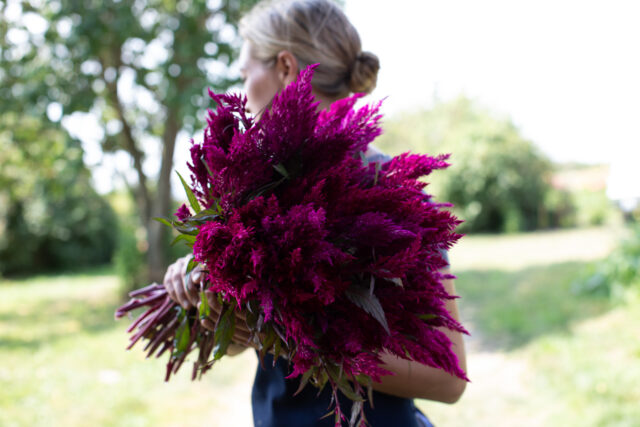
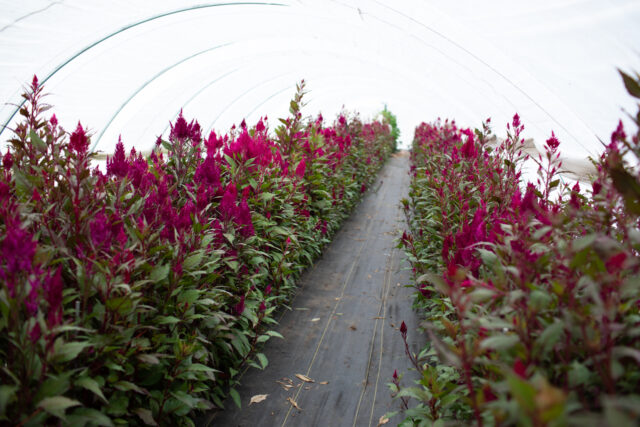 While I tend to be most often drawn to soft pastel colors, there’s always a place for richer, more vibrant tones, too. Sangria Mix is composed of towering deep grape-purple and vivid magenta plumes that draw a lot of attention.
While I tend to be most often drawn to soft pastel colors, there’s always a place for richer, more vibrant tones, too. Sangria Mix is composed of towering deep grape-purple and vivid magenta plumes that draw a lot of attention.
Plants have a vigorous branching habit, deep maroon stems, and emerald-green foliage with a striking purple cast. This blend is the perfect addition to a jewel-toned color palette.

 The early-flowering variety ‘Dusty Rose’ (previously named ‘Fruit Punch’) has changed quite a bit over time. Through the refinement process I’ve been able to nearly eliminate the magenta and burgundy fans that used to be part of the mix, so the original name no longer fit.
The early-flowering variety ‘Dusty Rose’ (previously named ‘Fruit Punch’) has changed quite a bit over time. Through the refinement process I’ve been able to nearly eliminate the magenta and burgundy fans that used to be part of the mix, so the original name no longer fit.
Fan-shaped blooms are soft blush with a rose wash and a subtle silvery-green undertone. Plants have rich garnet-red stems and long, slender green leaves with beautiful cranberry veining.
This variety originated from an unexpected cross between ‘Vintage Rose’ and Supercrest mix. What resulted were plants that possessed the Supercrest flower form, but Vintage Rose’s unique pastel coloring and tall dark stems.

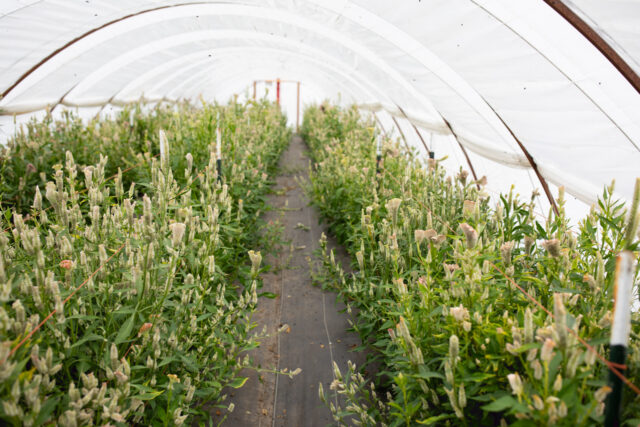 One of my favorite celosias to grow here in the Pacific Northwest is the Supercrest mix because it flowers incredibly early, does well in cooler climates, and has a somewhat compact plant habit. For the last few years I’ve been working on narrowing down the mix into a very soft pastel color range and that is how ‘Pink Chenille’ was born.
One of my favorite celosias to grow here in the Pacific Northwest is the Supercrest mix because it flowers incredibly early, does well in cooler climates, and has a somewhat compact plant habit. For the last few years I’ve been working on narrowing down the mix into a very soft pastel color range and that is how ‘Pink Chenille’ was born.
This mix includes soft pink, pale peach, and champagne. Long, slender stems are topped with a range of wavy, fan-shaped, and spiky textural flower heads. Blooms add a unique, velvety quality to arrangements. Plants have light green foliage and a vigorous branching habit. These colors are perfect for wedding work.

 ‘Coral Reef’ is a special selection that was made from the Supercrest mix that includes a more vivid color range including orange, salmon, peach, raspberry, and marigold. The vigorous plants have a branching habit and are one of the earliest celosias to flower.
‘Coral Reef’ is a special selection that was made from the Supercrest mix that includes a more vivid color range including orange, salmon, peach, raspberry, and marigold. The vigorous plants have a branching habit and are one of the earliest celosias to flower.
This mix is filled with the most unique coral-like blooms—they look as if they belong in the sea.
 The second group I want to highlight from our breeding program are zinnias. What I love most about these flowers is that they are incredibly easy to grow, are the perfect first crop for beginning gardeners, and are reliable, prolific producers no matter where you garden.
The second group I want to highlight from our breeding program are zinnias. What I love most about these flowers is that they are incredibly easy to grow, are the perfect first crop for beginning gardeners, and are reliable, prolific producers no matter where you garden.
 In addition to churning out buckets and buckets of beautiful, long-stemmed blooms that are perfect for cutting, they are well-loved by pollinators.
In addition to churning out buckets and buckets of beautiful, long-stemmed blooms that are perfect for cutting, they are well-loved by pollinators.

 Zinnias are the flowers that kicked off my flower breeding journey and it all started with the discovery of ‘Golden Hour’ back in 2016. This variety is named for the most beautiful time of day—the hour before the sun sets on the horizon.
Zinnias are the flowers that kicked off my flower breeding journey and it all started with the discovery of ‘Golden Hour’ back in 2016. This variety is named for the most beautiful time of day—the hour before the sun sets on the horizon.
Large flowers come in a range of warm honey and cantaloupe shades that look as if they are glowing. As flowers age, the lower petals take on the faintest cranberry edging that beautifully complements their red eyes. This is the first variety bred on the farm and is still my very favorite.

 Another really special large-flowered variety is ‘Alpenglow’, which I discovered many years ago in a long row of ‘Golden Hour’ plants as an off type. I’ve been working to refine its enchanting color range of creamy linen, pale peach, and dusty rose flowers.
Another really special large-flowered variety is ‘Alpenglow’, which I discovered many years ago in a long row of ‘Golden Hour’ plants as an off type. I’ve been working to refine its enchanting color range of creamy linen, pale peach, and dusty rose flowers.
The large pastel blooms sit atop long, strong stems and have an unusual iridescent lavender ring around their striking purple eyes. As flowers age, their petal tips turn a muted rosy pink. This rare color combination gives the blooms an almost opalescent quality.
They pair perfectly with ‘Limelight’ hydrangeas in September. You have to grow it to believe the color!

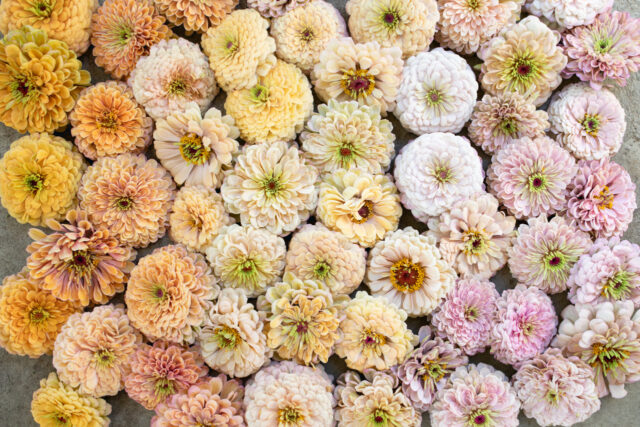 Of all the zinnias that have been born here on the farm, ‘Precious Metals’ might be the most magical. This giant-flowered mix includes shades of linen, icy lavender, pale pink, soft peach, and palomino. As flowers age, the lower petals often fade to turquoise dusted with lavender, giving blooms an icy metallic quality.
Of all the zinnias that have been born here on the farm, ‘Precious Metals’ might be the most magical. This giant-flowered mix includes shades of linen, icy lavender, pale pink, soft peach, and palomino. As flowers age, the lower petals often fade to turquoise dusted with lavender, giving blooms an icy metallic quality.
The flower heads are dense and leathery and the backs of the petals have apple-green veining. To experience their full range of coloring, don’t cut too soon and allow flowers to mature on the plant.

 We offered Unicorn Mix for just one season a number of years ago and people still write in asking when it will be back because they loved it so much. I’m thrilled it’s finally returning!
We offered Unicorn Mix for just one season a number of years ago and people still write in asking when it will be back because they loved it so much. I’m thrilled it’s finally returning!
Medium-sized, domed blooms come in an enchanting range of colors, including raspberry, tangerine, magenta, lemon, apricot, dusty lilac, and blush—all with striking lavender centers.
What makes these flowers so unique is that they have a multitoned ombre effect and many of the blooms possess a rainbow-like quality.
Out of the more than 130 zinnia varieties growing here on the farm, when asked to vote, the team picked Unicorn as their collective favorite, hands down.
To experience their full range of coloring, don’t pick them too soon and allow flowers to mature on the plant.

 As you’re looking at all of the new varieties that we’ll be making available, it could be easy to pass over the ‘Victorian Wedding’ mix because it’s not nearly as showy as some of the others at first glance.
As you’re looking at all of the new varieties that we’ll be making available, it could be easy to pass over the ‘Victorian Wedding’ mix because it’s not nearly as showy as some of the others at first glance.
But when it comes to flower production and the total number of blooms per plant, these babies are absolute workhorses! The stocky plants are so smothered in flowers during the summer months that you can barely see the foliage.
The petite, mostly double blooms come in a highly sought-after color range of buff, pale peach, rose-pink, blush, and the occasional soft orange that is a floral designer’s dream. They remind me of little French macarons and have a very long vase life.

 ‘Little Flower Girl’ was my nickname growing up and I knew that I wanted to pass along the title to a special variety someday. This adorable early-flowering pastel mix features darling miniature flowers in shades of blush, soft pink, pale peach, and champagne.
‘Little Flower Girl’ was my nickname growing up and I knew that I wanted to pass along the title to a special variety someday. This adorable early-flowering pastel mix features darling miniature flowers in shades of blush, soft pink, pale peach, and champagne.
Tall, strong, slender stems carry single, semi-double, and the occasional double blooms that are perfect for arranging, especially when it comes to weddings. They are especially well-loved by pollinators.
 One of the things that I’m most excited about sharing as part of this special seed release is four beautiful mixes that were created in collaboration with my flower breeding friend Kori at Dawn Creek Farm. You can read a wonderful interview with her here.
One of the things that I’m most excited about sharing as part of this special seed release is four beautiful mixes that were created in collaboration with my flower breeding friend Kori at Dawn Creek Farm. You can read a wonderful interview with her here.
 Kori is a flower farmer and plant breeder who has made incredible progress in developing new varieties for the marketplace. We have been working together for the past couple of years on refining these mixes with the intention of helping to get her magical varieties out into the world in a bigger way.
Kori is a flower farmer and plant breeder who has made incredible progress in developing new varieties for the marketplace. We have been working together for the past couple of years on refining these mixes with the intention of helping to get her magical varieties out into the world in a bigger way.
I’m thrilled to have the Dawn Creek beauties as part of our collection!

 Dawn Creek Blush is a beautiful large-flowered pastel mix that produces towering plants that are a sight to behold. Blooms come in a range of soft pink, the palest lavender, and blush, with the occasional ivory and soft peach making an appearance.
Dawn Creek Blush is a beautiful large-flowered pastel mix that produces towering plants that are a sight to behold. Blooms come in a range of soft pink, the palest lavender, and blush, with the occasional ivory and soft peach making an appearance.
Plants have long, strong stems and are incredibly productive. Many of the blooms have a notable cactus-like form and petals are displayed in varying levels of fullness.

 Dawn Creek Peach is a warm, dreamy mix that includes buff, peach, apricot, and faded coral, with the occasional blush. Plants have long, strong stems and are incredibly productive.
Dawn Creek Peach is a warm, dreamy mix that includes buff, peach, apricot, and faded coral, with the occasional blush. Plants have long, strong stems and are incredibly productive.
Many of the flowers have a cactus-like form in a wide range of shapes and sizes, including some with tufted centers. There are so many fun treasures in this collection to be discovered.

 Dawn Creek Honey is a warm, buttery mix that includes a beautiful range of buff, peach, honey, and cream with a subtle gold wash, as well as the occasional dandelion yellow that loves to make an appearance.
Dawn Creek Honey is a warm, buttery mix that includes a beautiful range of buff, peach, honey, and cream with a subtle gold wash, as well as the occasional dandelion yellow that loves to make an appearance.
The large flowers are carried on long, strong stems and many have a cactus-like form, with varying degrees of fullness.
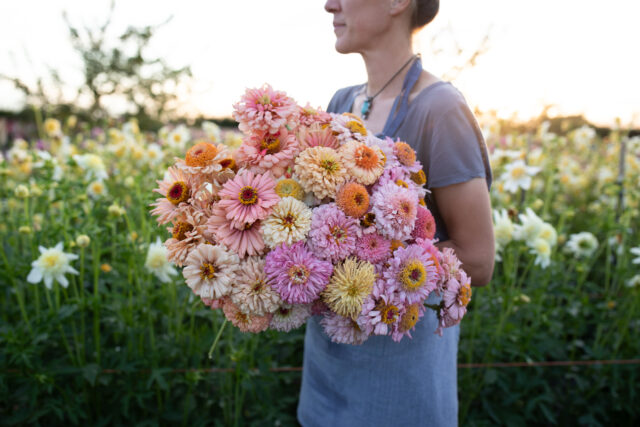
 Here on the farm, there are dozens of different varieties in the works that have come from Kori’s original seeds and the Dawn Creek Pastels mix is a blend of all the different selections that we’ve got cooking.
Here on the farm, there are dozens of different varieties in the works that have come from Kori’s original seeds and the Dawn Creek Pastels mix is a blend of all the different selections that we’ve got cooking.
Large flowers come in a muted rainbow of colors, including coral, peach, apricot, strawberry, pink, blush, buff, and gold, plus a few other surprises.
Many of the blooms will have a cactus-like form with varying degrees of fullness, while others may exhibit tufted or domed centers. This mix has so many unique treasures to discover.
 The last group of plants that we’ve been working on as part of this special breeding variety release are dahlia seed mixes. We’ve been able to create four unique mixes that produce flowers in a relatively distinct range of flower forms by collecting seed from separate fields.
The last group of plants that we’ve been working on as part of this special breeding variety release are dahlia seed mixes. We’ve been able to create four unique mixes that produce flowers in a relatively distinct range of flower forms by collecting seed from separate fields.

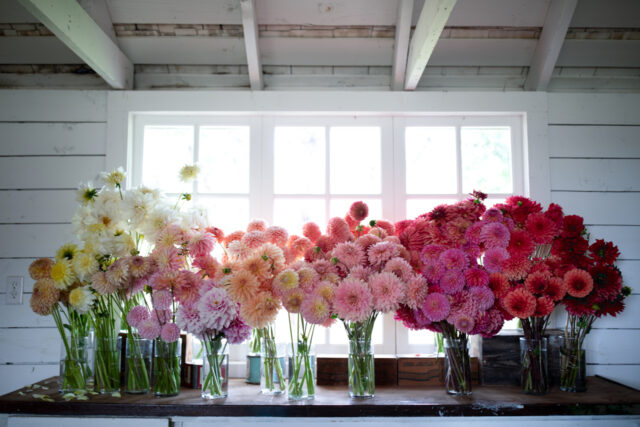 One of the most exciting and surprising discoveries I made early on my dahlia-growing journey was learning how new varieties were created. Unlike tubers or cuttings, which produce an exact clone of the plant they come from, dahlias grown from seed offer a treasure trove of new possibilities, each one something that’s never existed before. If you discover a variety you love, tubers can be saved and planted out the following year—and you even get to name them!
One of the most exciting and surprising discoveries I made early on my dahlia-growing journey was learning how new varieties were created. Unlike tubers or cuttings, which produce an exact clone of the plant they come from, dahlias grown from seed offer a treasure trove of new possibilities, each one something that’s never existed before. If you discover a variety you love, tubers can be saved and planted out the following year—and you even get to name them!
 In my experience, anemone-flowered dahlias are stingy seed producers so every one of the seeds in this mix is a tiny treasure. We collected these ‘Cancan Girls’ seeds from a breeding field of anemone types and so far about 70% of the plants grown from this seed produce anemone-flowered blooms.
In my experience, anemone-flowered dahlias are stingy seed producers so every one of the seeds in this mix is a tiny treasure. We collected these ‘Cancan Girls’ seeds from a breeding field of anemone types and so far about 70% of the plants grown from this seed produce anemone-flowered blooms.
 This dahlia seed mix is filled with a dazzling rainbow of tufted blooms in all shapes and sizes. The rich color range includes reds, maroons, pinks, purples, and many bicolors—no two plants will be the same! If you love this form, ‘Cancan Girls’ is a must grow. We probably won’t offer it again in the future because it is so labor-intensive to produce, so be sure to get the seeds while you can.
This dahlia seed mix is filled with a dazzling rainbow of tufted blooms in all shapes and sizes. The rich color range includes reds, maroons, pinks, purples, and many bicolors—no two plants will be the same! If you love this form, ‘Cancan Girls’ is a must grow. We probably won’t offer it again in the future because it is so labor-intensive to produce, so be sure to get the seeds while you can.
 ‘Floret’ (what started as C33) is one of the first dahlias I bred here on the farm. The flowers are a strange fusion between collarette and anemone forms. Blooms start out candy pink and fade to warm peach with an iridescent lavender wash as they age.
‘Floret’ (what started as C33) is one of the first dahlias I bred here on the farm. The flowers are a strange fusion between collarette and anemone forms. Blooms start out candy pink and fade to warm peach with an iridescent lavender wash as they age.
But what I love most about ‘Floret’ is that of all the dahlia varieties I’ve ever collected seed from, nearly all her offspring possess similar characteristics to their mother, including her unique form and soft, unusual coloring. I’ve never grown seed from a dahlia variety with such a high percentage of “keepers.”

 Seed from the ‘Petite Florets’ mix was collected from ‘Floret’ and is a range of pastel tones, including peach, apricot, dusty rose, lavender, sunbleached raspberry, and buttercream, all with a hauntingly beautiful iridescent wash.
Seed from the ‘Petite Florets’ mix was collected from ‘Floret’ and is a range of pastel tones, including peach, apricot, dusty rose, lavender, sunbleached raspberry, and buttercream, all with a hauntingly beautiful iridescent wash.
A large percentage of the blooms are either collaretes or anemones, many of which have snipped petal tips, long feathery ruffles, and twizzly eyelashes encircling their fuzzy centers. Every one of them is pure magic!

 Another beautiful new mix is ‘Shooting Stars’, which was collected from an entire field of collarettes and features an incredible range of star-shaped flowers, including singles, collarettes, orchettes, orchids, and other fun surprises—no two plants will be the same!
Another beautiful new mix is ‘Shooting Stars’, which was collected from an entire field of collarettes and features an incredible range of star-shaped flowers, including singles, collarettes, orchettes, orchids, and other fun surprises—no two plants will be the same!
You’ll find flowers with snipped edges, rolled petals, stripes, streaks, and speckles in every color of the rainbow. The bees love this mix and it’d be worth planting just for the pollinators.

 Last but not least is ‘Bee’s Choice’—one of the most popular seed mixes we’ve ever offered. This year’s mix was collected from all of our different dahlia breeding patches on the farm and includes a wide range of shapes, sizes, and colors!
Last but not least is ‘Bee’s Choice’—one of the most popular seed mixes we’ve ever offered. This year’s mix was collected from all of our different dahlia breeding patches on the farm and includes a wide range of shapes, sizes, and colors!
Most of the flowers will have open centers, which will attract lots of pollinators to your garden but you should also get some fun surprises in the mix including some balls, informal decoratives, and maybe an anemone or two.
 If you’ve made it to the end of this post, a huge thank you for taking the time to meet all of the Floret Originals and letting me share my overwhelming excitement about them with you.
If you’ve made it to the end of this post, a huge thank you for taking the time to meet all of the Floret Originals and letting me share my overwhelming excitement about them with you.
To celebrate the release of these special seeds we’re hosting a giveaway of 10 deluxe seed collections. Each collection includes all of the new varieties (26 packets!) and a beautiful growing guide. For a chance to win, please leave a comment below sharing what breeding varieties you’re most excited to add to your garden this season. Winners will be announced on February 5. Please note: Because we can’t yet send the breeding varieties internationally, this giveaway is open to U.S. and Canadian residents only.
Update: A huge congratulations to our winners: Angela, Katelyn Lacey, Tai Quirke, Chris, Leah, Stephanie Peoples, Autumn Mulverhill, Andrea K., Anne-Sophie and Ruth Goethals.
Please note: If your comment doesn’t show up right away, sit tight; we have a spam filter that requires us to approve comments before they are published.






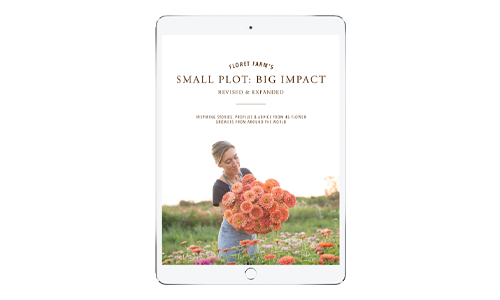
Naomi on
I love, love your first two books and can’t wait to get your dahlia book! You put on fire my interest in cut flowers! My girls and I filled a small section of our vegetable garden with cut flowers and had so much fun arranging bouquets to give away! In July we’re moving to an old farm that we’re fixing up and want to put flowers out to sell. Can’t wait to try out some of your unique varieties of flowers in 2026!!